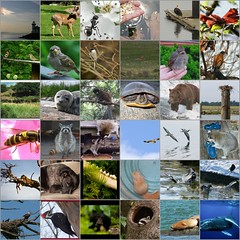This fall at school has been a blur both as a teacher and as a student. At reaching the mid-point in the CCK08 course, I'd like to share a number of observations, each of which might have become a blog post would time have been available.

1]
Where is everyone? The number of 'active' course participants has settled to the point where receiving Moodle updates via email is a reasonable expectation. Beyond RSS feeds, I'm left wondering whether or not there is a mechanism to track continued involvement; and whether or not an exit survey would provide insight as to where/why so many have disappeared...
2]
Just another online course? It's only in recent weeks when the 'noise' of the Moodle discussions has calmed down to the point that I'm willing to notice that learners are connecting their ideas to one another. Even though the 'Moodlers' are finally connecting, responses are still infrequently attached to the range of blog posts in the connect-osphere. Based on my own online teaching/learning experience, the CCK08 course is more and more feeling like a traditional online course.
3]
Past Connectivist Life on the Back Burner! In order to keep up with selected readings, the Daily, and posts from my peers, I've lost touch with other aggregated feeds. (i.e., I haven't been reading many posts from outside of the course).
4]
The Fourth 'R'! It took a while, but frequent posters finally seem to be building relationships and networks. In my own experience, I've found this feeling of 'knowing your classmates' to be a critical component in building an online community. While the random (chaotic?) grouping of participants has allowed for individual exploration, intentional grouping might have led more learners to engage more deeply. Early on, it was challenging to build relationships with so many disparate participants, and though the number of voices has dwindled recently, I believe this has actually benefitted those who continue to read/think/respond.
5]
Differentiation... Not so much. Although classroom teachers have in recent years, embraced this concept to varying degrees, the assignments in this course have for the most part resulted in traditional responses (e.g., reflections; links to personal/professional practice). While the freedom to pursue areas of personal interest has been announced, 'similar-ation' has trumped 'differentiation'. Only the metaphors and blog titles seem to be unique.
6]
A Daily Lifeline! With a real job, and a real family life, it's been challenging to reconcile the many CCK08 channels. The 'Daily' digest has let me keep in touch even on days when I couldn't read, listen to, or think about course content. I consider this document to be the glue that has been holding this course together.
7]
Looking to Forge Links... I signed up for this course, in large part to experience connectivist learning first hand, but I've found time to reach out to only a limited number of colleagues. I think that making a more concerted effort to post to the Moodle would be a logical next step.
8]
Synchronicity Works! With the participation of guest panelists, these discussions have been my favourite way to connect with learners. Whether live or recorded, these interactive sessions have provided opportunities for interaction among all present learners, be they instructors or 'back-channel' participants. Often beginning with semi-traditional lectures, participant questions and comments have sometimes led these discussions to interesting territory. Gladly, the Eastern Standard Time zone allows for my occasional live participation.
9]
Pre-requisite Expertise Recommended. While such courses can remain open, it wouldn't hurt to recommended specific prior experience:
* Know first-hand, how to use of read/write tools like wikis, blogs, microblogs, social bookmarks, e-conference tools...
* Model Stephen's "
7 Habits of Highly Connective People" prior to course participation.
10]
Engage Real World Colleagues... I would encourage attendees to augment their online activity with discussions in the real world. Although it may not be easy to find interested colleagues, or for course facilitators to track such participation, the ability to work with known peers would definitely enhance one's understanding of course content, and could lead small groups of educators to enhance their own professional learning communities.
Photo Credit: Leo Reynolds
 My most recent brain food, was Seth Godin's nutrient-packed "Tribes: We Need You to Lead" which fit perfectly in a recent two way trip to the extreme southwest part of Ontario. The book is very much an invitation to listeners to stop waiting and to start leading.
My most recent brain food, was Seth Godin's nutrient-packed "Tribes: We Need You to Lead" which fit perfectly in a recent two way trip to the extreme southwest part of Ontario. The book is very much an invitation to listeners to stop waiting and to start leading.  Grab onto the rope...
Grab onto the rope... 
























